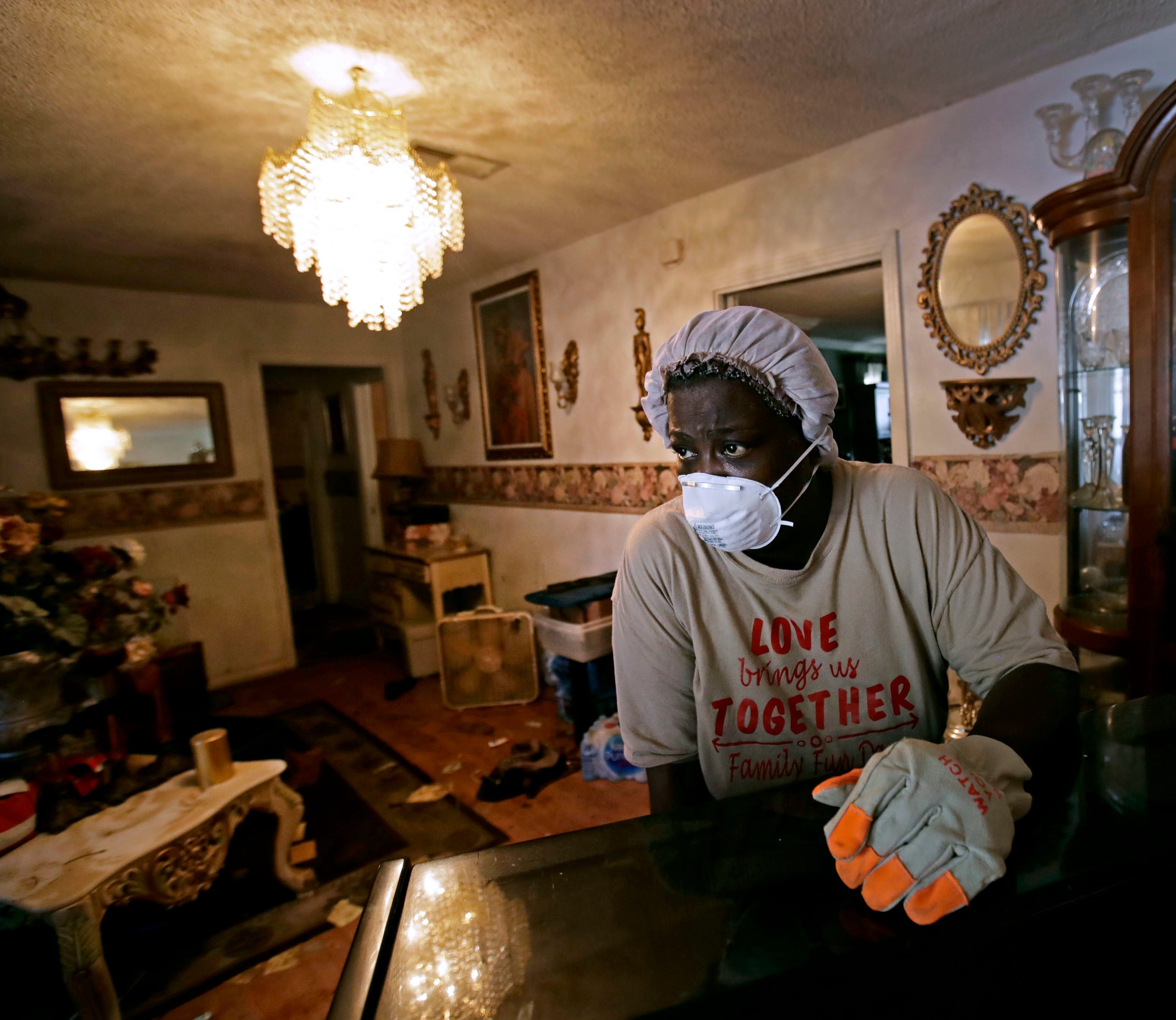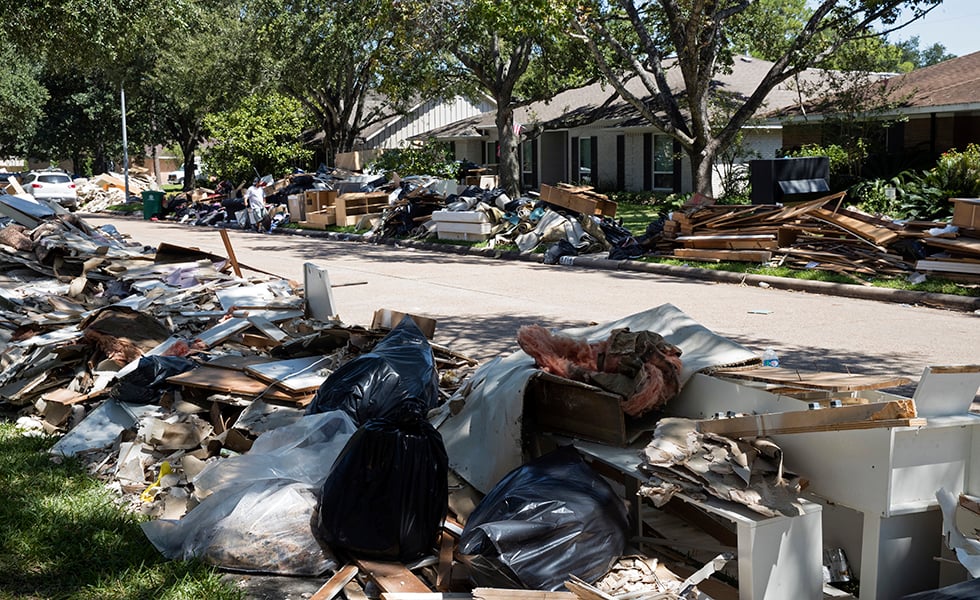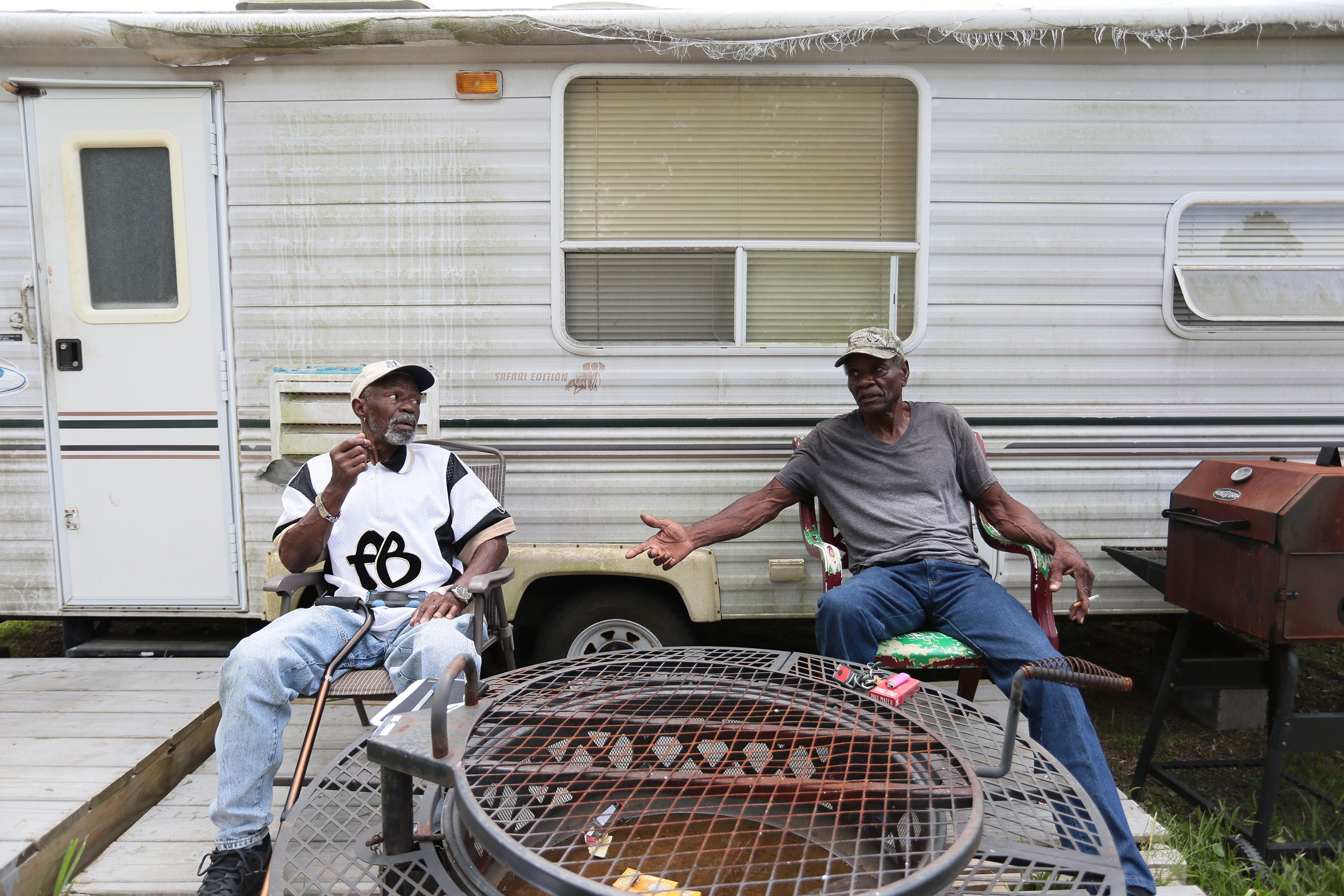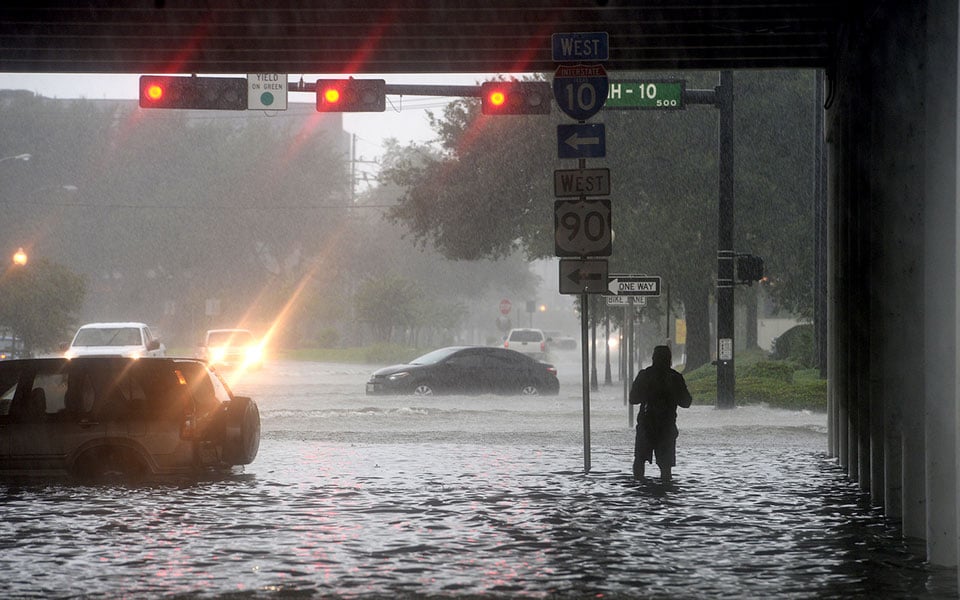
Communities of Color in Houston Will Face Another Hurricane Season Without Adequate Flood Control
After nearly $4 billion in county and federal funding for infrastructure projects, the city’s most vulnerable neighborhoods still aren't protected.

Above: Lois Rose pauses while salvaging items from her flood-damaged house on August 31, 2017, in Houston while the city recovered from record flooding caused by Hurricane Harvey.
Doris Brown’s home in Scenic Woods, a neighborhood in northeast Houston, flooded four years ago during Hurricane Harvey when water rose over the banks of Halls Bayou. In the aftermath, local officials promised to build much-needed flood control infrastructure in the neighborhood, but the projects didn’t get built in time to stop Brown’s house from flooding again two years later in 2019, during Tropical Storm Imelda. In 2020, she finally finished repairing her home from Harvey damage, but this spring, when heavy rains hung over the city, it flooded again. Now, if a hurricane forms in the Gulf of Mexico and barrels towards Texas, Brown’s home, and others in her neighborhood, will likely flood for the fourth time. No new flood control projects have been built along the bayou since Harvey hit in 2017.
The Harris County Flood Control District (HCFCD) has been promising detention ponds and drainage improvement projects since 2019, when voters approved a historic $2.5 billion bond fund to build such infrastructure. The county adopted equity principles that suggested that low-income neighborhoods, which have been under-resourced for decades, should be prioritized in funding distribution. Districts along Halls Bayou, some of Houston’s poorest neighborhoods and predominantly Black and Latinx, lack even the most basic infrastructure: Instead of concrete culverts, they have grassy ditches to funnel rainwater into storm sewers. The ditches often become clogged, causing streets to flood during heavy rainstorms. When residents call 311, no one comes out to clear the ditches. A few years ago, tired of waiting for someone else to clean up the mess, Brown co-founded an advocacy group called Northeast Action Collective and volunteers from the group clean out the ditches themselves. “They took our tax money,” Brown says. “But the city never had enough money for our neighborhood.”
Along Halls Bayou, HCFCD faces a $272 million shortfall for the projects it was supposed to build with the bond money from local taxes. Despite the equity principles adopted by the county, most of the bond money has already been spent in wealthier parts of the city, like River Oaks, where million-dollar homes overlook Buffalo Bayou. To make up for the deficit, Harris County banked on money from the U.S. Department of Housing and Urban Development (HUD): a $4.3 billion federal fund created in 2018 for disaster recovery, including mitigation projects, for areas affected by Hurricane Harvey. HCFCD’s projects were eligible for some of that money, and the state’s General Land Office (GLO) was charged with distributing those funds. But by and large, those funds never made it to low-income communities of color that needed it most.
The GLO, overseen by George P. Bush, rejected the county’s applications for $200 million to fund a watershed mitigation project for Halls Bayou. It rejected $40 million worth of application for drainage improvement in Corpus Christi and Nueces County, which is a few miles shy of where Harvey made landfall. The GLO also rejected several applications from Jefferson County, where Port Arthur was hit hard, for drainage and detention projects which totalled more than $219 million.
Instead, the agency sent money to whiter, more rural counties. HUD had initially identified counties that were most in need of the funding, but allowed the GLO to expand the list of counties eligible for aid. HUD’s regions had a larger share of cities and communities of color in need of funding; the GLO specifically added counties which were predominantly white, rural, and had experienced little damage from Harvey. The agency awarded money to projects like a $6.5 million sewer system improvement project in Madisonville,100 miles from the coast, and a $4.4 million drainage project in Milam County, which is closer to Austin than the Gulf Coast. The small town of Yoakum, which was about 80 miles north of Harvey’s landfall and served as an evacuation spot for people fleeing flood waters, received nearly $13 million from the GLO for water and electrical system upgrades.
According to Texas Housers, a low-income housing advocacy group, 80 percent of the proposed projects in regions that the federal government identified went unfunded, a stark contrast to the 15 percent of rejected projects in regions picked by the state. The decisions baffled environmental experts, politicians, and bureaucrats alike.
“I was mad as hell,” Brown says. “They are playing around like our lives don’t matter.”
In late June, the advocacy group Northeast Action Collective and Texas Housers filed a complaint with HUD accusing the GLO of intentionally violating the Fair Housing Act by devising a system that awarded most of the funds to wealthier, whiter communities and systematically excluding urban counties and areas with a larger share of communities of color. Harris, Jefferson, and Nueces counties, all of which were left out of the funding, have sizable Black and Latinx populations. Northeast Action Collective and Texas Housers are asking HUD to investigate, in the hopes that Texas officials will be required to change its methods for future rounds of funding. This week, Congress said it will review the GLO’s decisions; U.S. Representative Al Green, a Democrat from Houston, wants Bush to testify during a hearing. “We don’t want this to become the norm,” Green told the Houston Chronicle. “We want this to be a one-off. And the best way to make it a one-off is to let people know we are not going to allow this to happen.”
“I just simply do not see evidence of a cohesive strategy,” says Jim Blackburn, an environmental law professor and co-director of Rice University’s Severe Storm Prediction, Education, and Evacuation Disaster Center. Blackburn says areas that were most impacted by Harvey were overlooked, along with regions facing future risks from climate change.The fact that GLO is denying funding to any projects in Northeast Houston is a glaring omission, he says. “That area is still incredibly impacted to this day from [hurricanes] Harvey and Imelda. These are people that are being hurt by flooding and by any criteria I would have used, they would have received a proportionate share of funding.”
In response to public pressure, Bush, the GLO’s director, announced he would ask HUD for an additional $750 million for Harris County specifically, but he has yet to explain the agency’s process for awarding contracts. Texas Houser’s analysis concluded that if the GLO hadn’t created a discriminatory system, the county likely would have originally been awarded far more than $750 million.
But advocates say that the blame is circular: If Harris County Flood Control District had followed the equity principles which were supposed to guide the bond funding, it wouldn’t have had to rely on the state or federal government to fund projects in the poorest neighborhoods of the city.
“This isn’t the first time that [the city or county] have been given millions and millions of dollars, or have had a chance at millions of dollars to do mitigation projects,” says Christina Rosales, Texas Housers’ deputy director. “They’ve had many, many chances, and they’ve shown even recently that they’re not going to prioritize the people who need these projects most.” In 2017, for example, Texas Housers filed a civil rights complaint with HUD over the City of Houston’s failure to build basic flood control projects in communities of color. The complaint found that lack of flood control mapped onto the city’s historic patterns of segregation. It is still being investigated by HUD. In the meantime, no one—not the city or the county, nor the state or federal government—has invested in poor neighborhoods of color to protect them from floods.
In a statement, HCFCD said that no projects had been delayed due to a lack of funding to date; projects which were able to secure additional funding through partnerships have made more progress. The agency did not provide an answer as to why projects in low-income areas were heavily reliant on federal funding.
In the middle of the 2021 hurricane season, Brown is anxious about potential flooding again. It took more than two years for her to repair her home after she was denied aid from the federal government. Another hurricane could set her back by years. “Anytime we have a disaster, it affects our neighborhood because we never recovered from another one,” she says. She delivered the same message to the Harris County Commissioner’s Court a few weeks ago, when she testified to demand that the county live up to its promises of equity: “We are sick and tired of being treated like second class citizens.”


